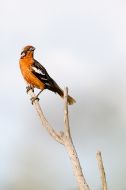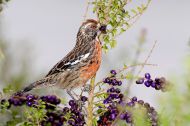Rufous-tailed Plant-Cutter
Rara
Phytotoma rara
Length: 205mm. Sexes unlike. Male: bill brown with mandible pale grey; iris orange; forehead and crown rufous chestnut; hind neck and above reddish brown with fine grey margins and centre of feathers dark brown forming broad and abundant streaks; lower back and uppertail coverts grey with thin dark brown streaking; central rectrices brown; remainder rufous chestnut at base and a very broad blackish terminal band. Supercilium white framing auriculars up to half their extension; auriculars blackish with white transversal markings; throat, foreneck, breast, belly and undertail coverts deep rufous; sides of breast with blackish streaking; flanks grey stained rufous and blackish striation. Wing coverts black, median coverts show a broad whitish outermost margin forming bands; greater coverts black with outermost edge whitish and white to tip; remiges black with white margined tertiaries and white in outer vexillum of primaries. Legs grey. Average weight: 60g. Female: bill as in male; iris orange; upper part of head, hind neck and above mostly buffy brown profusely streaked dark brown; supercilium buff; malar region and auriculars buffy cream with blackish mottling; throat, foreneck, breast, flanks and belly buffy cream with dark brown streaks that are thinner and sparser on belly than on breast; undertail coverts rufous with blackish streaks; rectrices as in male but slightly paler; wings as in male but more greyish brown. Legs as in male. The male juveniles resemble the females and both sexes have brown irides. Habitat and behaviour: it frequents scrubby country, fringes of open woods and forests; it may be observed standing at the top of trees and shrubs; it is found in pairs or average-size groups; its call clearly resembles that of a lamb’s; it is wary and upon danger it hides in the thickest vegetation.
The Rufous-tailed Plant-Cutter feeds largely on sprouts, buds, fruits and leaves; it also cuts small twigs and leaves. Occasionally it feeds on the ground. Behaviour is markedly territorial. Given the soft consistency of their diet, they always have food matter stuck on their bills which affects their colouring.
Nests are dome-shaped, and are made with plant matter and built in the topmost branches of trees and shrubs; clutch size is up to four green eggs with brown spots. Range: all along the Andean and sub-Andean region,
the neighbouring ecotones and fringes of steppes, from Neuquén to Santa Cruz.
Illustrated Handbook of the Birds of Patagonia
Kindless: Kovacs Family
|












